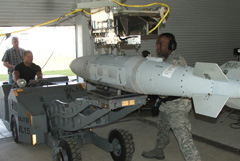
| STEM Facility Conducts
F-35 Lanyard Risk Reduction Test |
|
|
6/17/2008 - EGLIN AIR FORCE BASE, FL -- The 46th Test Wing recently lent a hand to Lockheed Martin Company to perform a risk reduction and development test of weapon lanyards for the F-35 System Development and Demonstration program at the Simulated Environment for Munitions facility here. The tests began March 25 and were performed by the 46th Test
Wing's 46th Operations Group, 780th Test Squadron, Air-to-Surface
Test Flight, Weapons Test Branch, as well as The purpose of the test series was to demonstrate flight test suitability of the lanyard configurations that were developed for the weapons carried in the F-35 weapon bays during the SDD program. If not, the tests determine if alternate lanyard configurations or components are required for further development. Lockheed Martin is developing a conventional take-off and landing (CTOL) F-35 version for the Air Force, a short take-off and vertical landing (STOVL) version for the Marine Corps and a carrier variant (CV) for the Navy. All variants have the capability of internal carriage of weapons in the two weapon bays. Each weapon bay has two weapon stations, an air-to-ground weapon station and an air-to-air weapon station. At the STEM facility, BRU-67 and -68 series racks were used to eject inert stores into the pit at the static ejection test facility. The racks were developed specifically for the F-35 aircraft. "Unlike legacy aircraft racks that use explosive charges to eject the store, the F-35 racks use a pneumatic power source to power the eject pistons," said suspension and release equipment and design lead Jim Shelingoski, F-35 Weapons Integration IPT, 685th Armament Systems Squadron. The BRU-67 is carried in the weapons bay of the STOVL aircraft at the two air-to-ground store carriage locations. The BRU-68 is carried in the weapons bay of the CTOL and CV aircraft. "The BRU-67 and -68 are new designs that include a sway brace mechanism that is integral to the ejection pistons," said joint technical data lead Ken Gibson, F-35 Weapons Integration IPT, 685th ARSS. "For the lanyards that are routed in close proximity to the ejection pistons and sway braces, we want to make sure the lanyard designs are compatible with the racks during operation and do not foul with the sway braces." Munitions used during the test included the GBU-31(V)1/B, GBU-31(V)2/B, GBU-31(V)3/B, GBU-32(V)2/B and GBU-12D/B. Evaluators tested lanyards that activated the FZU-32, FZU-48 and FZU-55 on the various munitions, the FMU-143 on the BLU-109 version of JDAM and the Battery Firing Device and Wing Release Lever on the GBU-12. For each munitions store in the test matrix, evaluators tested a primary, preferred design and an alternate, back-up design. "This testing represents a big step in risk reduction of the F-35 weapon lanyard configurations," said lanyard test manager Jeanna Roti, F-35 Weapons Integration IPT, Lockheed Martin Aeronautical Company. "A successful outcome allows us to go to flight test confident that lanyards will function properly." Source: USAF Eglin AFB Press Release by Rick Phillips |
| |
